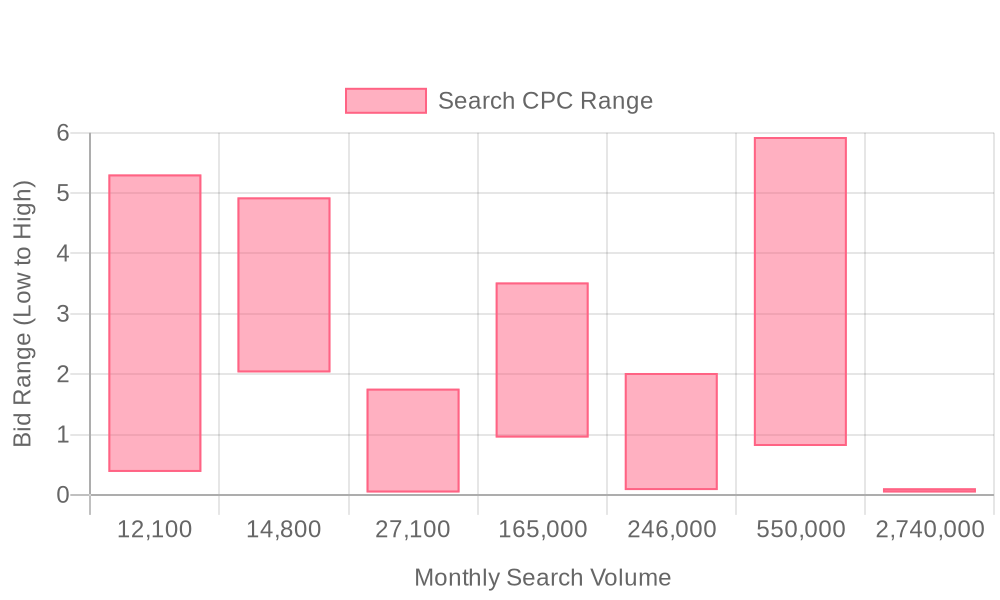
Supercharge your lead generation with a FREE Google Ads audit - no strings attached! See how you can generate more and higher quality leads
Get My Free Google Ads AuditFree consultation

No commitment
Supercharge your lead generation with a FREE Google Ads audit - no strings attached! See how you can generate more and higher quality leads
Get My Free Google Ads AuditFree consultation

No commitment
In today’s marketing landscape, effectively leveraging tools like Google Ads can revolutionize outreach efforts for Social Security Offices, bridging the gap between awareness and direct action. Prevalent challenges include missing key prospects due to inadequate tracking and delayed engagement, leading to missed opportunities. Platforms today provide essential insights into anonymous visitors, refining engagement profoundly. Google Ads serves as a strategic tool to intercept potential clients precisely when they're searching for services related to SSD/SSI claims. Its precision targeting aids Social Security Offices in reaching stakeholders at crucial moments, whether they’re seeking advice post-event or responding to informational materials, helping to prioritize engagement effectively.

Social Security Offices serve communities where effective outreach and timely engagement are critical. Integrating Google Ads into their marketing strategy allows these offices to connect with citizens actively searching for information or services, capturing demand at crucial touchpoints. For more guidance on the nuances of advertising in this space, review Google's advertising policies for government services, which outline key compliance considerations for regulated campaigns.
Modern data-driven marketing approaches address the challenge of missed opportunities by leveraging identification technology and advanced audience targeting. The ability to pinpoint visitors—even those who remain anonymous in standard analytics—empowers marketing teams to act on every signal of intent and convert high-value prospects who would otherwise go unnoticed.
Ready to transform your outreach? Get started for free with Sona.

Social Security offices operate in a complex environment where timely communication and resource allocation are paramount. Google Ads enables these organizations to precisely engage individuals who are actively searching for benefits information or application support, ensuring outreach efforts reach those with the highest intent. For expert articles and actionable insights on digital outreach, explore the Sona blog.
Specialized audience engagement is crucial for Social Security offices, as traditional media often casts too wide a net. With Google Ads, offices can direct resources toward users who are most likely to convert, reducing delays in follow-up and maximizing every interaction. Modern marketing teams can also leverage Sona Identification to move beyond anonymous website visits, identifying which companies and individuals are interacting with key benefit content for more informed prioritization.
Immediate demand capture is essential during periods of high activity, such as benefit filing deadlines or changes in policy. Google Ads campaigns can be activated or adjusted in real time to address surges in demand, engaging prospects exactly when they need support. By integrating real-time intent data, revenue teams can shift budget toward high-converting accounts and ensure that outreach aligns with actual beneficiary needs.
Expanding service visibility remains a challenge as underserved or emerging populations may not be reached through standard outreach. Google Ads grants Social Security offices the agility to target niche demographics, underserved regions, or new service offerings with precision, as detailed in this case study on marketing strategy for the Social Security Administration. Dynamic audience management ensures that as leads progress through the application process, messaging and targeting adapt, delivering relevant content at each stage.
Analyzed marketing insights provide closed-loop measurement, allowing Social Security marketers to see exactly which campaigns drive outcomes like application starts or appointment bookings. Advanced conversion tracking, including both online and offline actions, clarifies true return on investment and supports smarter budget allocation. Seamless CRM and ad platform sync makes it possible to funnel enriched audience data back into campaign workflows, ensuring future outreach is even more targeted and effective. Ready to optimize your Social Security campaigns? Get started for free with Sona.

Ready to optimize your Social Security office’s digital campaigns? Get started for free with Sona.

Growth for Social Security offices begins with a sharp focus on vertical-specific keywords. Rather than relying solely on broad or generic search terms, integrating highly targeted phrases related to Social Security services—such as "Social Security Disability Insurance application," "SSI eligibility requirements," or "nearest Social Security office"—enables campaigns to surface in front of citizens who are most likely to convert. This approach supports deeper personalization, allowing messaging and offers to align with the actual needs of different beneficiary groups. By layering these intent-driven keywords into a broader content strategy, Social Security offices can bridge the gap between awareness and action, reaching segments that generic campaigns often miss.
Competitor analysis is essential for mapping untapped audience segments and identifying gaps in outreach. By analyzing where other agencies or legal service providers fail to engage, Social Security offices can refine their campaigns to address overlooked needs and underserved regions. These insights help inform creative strategy, from crafting ad copy that resonates with specific demographics to deploying campaigns where competitors have a weaker presence. For more actionable tactics, explore our demand generation playbooks to discover strategies for reaching high-intent audiences.
Content retargeting further strengthens engagement by nurturing users through each stage of their journey. For example, when a visitor reads a guide on Social Security applications but does not complete an action, retargeting can deliver tailored follow-up content such as FAQ pages, eligibility checklists, or step-by-step video tutorials. With Sona, marketers can identify high-value visitors and companies, using real-time behavioral data to update and sync dynamic audiences. This enables budget to shift toward prospects showing strong in-market signals, while CRM and ad platforms remain in sync with enriched lead data. Advanced attribution tracks both online and offline conversions, providing a full view of campaign ROI and supporting continuous optimization for demand generation and citizen engagement. To see how these strategies can elevate your results, get started for free with Sona.

Social Security offices serve a diverse community with needs ranging from individual benefit claims to organizational compliance inquiries. Successful digital outreach demands segmenting these audiences to deliver relevant messaging throughout the customer journey. For proven frameworks and expert ideas, explore our actionable playbooks.
Segmenting allows Social Security teams to avoid generic campaigns that waste budget on low-intent queries. Instead, resources are allocated to audiences whose signals—such as recent eligibility searches or benefit application starts—indicate readiness to engage. Using real-time audience segmentation can help directly target these high-intent users for improved campaign efficiency.
Distinguishing between individual clients and organizational entities is foundational for Social Security advertising. Individuals may seek guidance on retirement, disability, or SSI eligibility, while organizations could require bulk data access or policy clarification. Building distinct profiles for each group ensures that messaging addresses their unique pain points, improving both engagement and trust. Insights from this case study on Social Security outreach illustrate how tailored segmentation can drive public engagement.
Intent signals further refine these segments. For example, recent interactions with eligibility checkers or queries about application timelines pinpoint users likely to convert. Leveraging intent signal tracking, marketers can update audience lists dynamically as citizens move from research to action, preventing outdated targeting and maximizing campaign relevance.
Tailoring ad groups ensures each audience segment receives messages aligned with their immediate needs. For individuals, ads can highlight step-by-step application assistance or clarify eligibility requirements. Organizations may see messaging around compliance protocols or direct support channels. Allocating budget at the segment level prevents overspend on broad, inefficient campaigns and allows for more granular testing of ad creative and landing pages. To understand industry benchmarks for these efforts, review Google Ads performance metrics.
Segment-specific ad groups also streamline reporting. Marketers gain clarity on which segments drive the most conversions, enabling agile budget shifts in response to changing demand. Integrating CRM and intent data, teams can sync enriched audience lists directly into Google Ads, ensuring that updates in lead status automatically refine targeting without manual intervention by using Destinations for seamless data activation.
Robust conversion tracking underpins every high-performing Social Security advertising initiative. Setting up clear events for form fills, phone calls, and consultation requests allows for precise measurement of campaign effectiveness. By syncing online and offline conversion data, organizations can attribute account visits or document pickups directly to digital interactions, closing the loop on performance. Discover how ad conversions tracking can connect each touchpoint to real outcomes.
Advanced tracking also supports real-time engagement. As inquiries or requests are logged, automated workflows can trigger timely responses, such as follow-up emails or appointment scheduling. This responsiveness not only improves citizen satisfaction but also ensures resources are allocated where they deliver the greatest impact on service delivery goals. Get started for free with Sona.

| Industry | Keyword | Monthly Search Volume | Competition Level | Low Bid | High Bid |
| Social Security Offices | social security offices | 12100 | LOW | 0.38 | 5.31 |
| Social Security Offices | social security disability phone number | 14800 | LOW | 2.03 | 4.93 |
| Social Security Offices | ssi office | 27100 | LOW | 0.04 | 1.76 |
| Social Security Offices | social security phone number | 165000 | LOW | 0.95 | 3.52 |
| Social Security Offices | social security card replacement | 246000 | MEDIUM | 0.08 | 2.02 |
| Social Security Offices | social security office near me | 550000 | LOW | 0.81 | 5.93 |
| Social Security Offices | social security administration | 2740000 | LOW | 0.04 | 0.11 |
Social Security offices face a distinctive challenge: engaging citizens at their exact moment of need while maintaining cost efficiency and compliance. Paid search, particularly Google Ads, allows these agencies to intercept high-intent users—those actively seeking information or assistance—transforming awareness into measurable action. For a deeper dive into compliance, see Google's advertising policies regarding government services and documents.
Strategic keyword targeting eliminates wasted spend on low-relevance queries, directly connecting citizens with the most relevant information or service. This approach minimizes friction and frustration for users, while enabling marketers to track engagement, conversions, and service outcomes with greater accuracy than traditional outreach. Explore more keyword and attribution best practices in the Sona blog.
When developing keyword lists for Social Security advertising, focus on terms that capture both intent and compliance:
Proactive use of negative keywords—such as “job openings,” “child benefits,” or “scams”—further refines targeting and prevents budget waste. By continuously monitoring search term reports and integrating CRM data, Social Security offices build a feedback loop, ensuring keyword strategies evolve with citizen needs and policy shifts.
To see how these strategies can transform your campaign results, get started for free with Sona.
Precision targeting is foundational for Social Security office campaigns. Start by categorizing keywords around core service offerings such as benefits consultation, legal representation for Social Security Disability (SSD), and appointment scheduling. Instead of relying on broad, generic terms, build lists with specific, long-tail phrases that reflect real-world search intent—such as “apply for Social Security benefits in [city]” or “disability lawyer for SSI claims.” Including local identifiers ensures ads reach audiences in the correct geographic areas, maximizing relevance and minimizing wasted spend. For additional insight on keyword selection in the retirement sector, review this list of effective SEO keywords for marketing retirement-related services.
Integrate negative keywords to exclude irrelevant traffic, like job seekers or unrelated legal inquiries. This strategic exclusion preserves budget and enhances qualified lead volume. By using Sona's identification tool that tracks visitor-level data and intent signals, marketers can identify high-intent searchers by both keyword and company, allowing for refined audience segmentation. As a result, Social Security offices can prioritize their budget toward prospects displaying immediate need or strong likelihood to convert.
Effective ad copy for Social Security offices must go beyond surface-level messaging. Headlines should directly address consumer pain points: confusion about eligibility, frustration with paperwork, or urgency around benefit approval. Use language that resonates with individuals facing real barriers, and position your office or firm as a reliable, empathetic guide through the process. Support claims with authentic success narratives, such as testimonials from clients whose benefits were secured swiftly or stories of navigating complex eligibility requirements. For real-world examples of effective messaging and outreach, you can explore this case study on marketing strategy for the Social Security Administration.
Calls to action should be direct and tailored to urgency—offering rapid consultations, eligibility checks, or easy appointment scheduling. Enhance the visibility and utility of each ad by including extensions like sitelinks to FAQs, phone numbers for instant contact, and location details for walk-in support. With data-driven insights on which pain points or offers generate the highest engagement, teams can dynamically test and iterate headlines and calls to action, ensuring every impression has the maximum chance to convert.
A seamless landing experience is non-negotiable for Social Security campaigns. Ensure the message from the ad aligns perfectly with the landing page, reducing friction and confusion for users transitioning from search to site. Segment landing pages by specific service lines—disability claims, retirement consultations, or legal assistance—so each visitor’s journey feels tailored and relevant. Address any potential disconnect by clearly restating the benefits and next steps promised in the ad copy.
Incorporate tangible value elements, such as video testimonials from real clients or visual timelines that demystify the application process. Strong, clear calls to action—like “Request your free eligibility assessment now”—should be prominent and mobile-optimized, ensuring accessibility and fast action on any device. By integrating real-time intent data, marketers can further personalize landing page content based on the user’s search history or prior interactions, increasing conversion rates and deepening engagement. For a practical next step on personalizing your campaigns, get started for free with Sona to unlock advanced intent data segmentation.
Successful Social Security advertising is iterative and insight-driven. Chart full conversion pathways, tracking both micro-conversions (form fills, calls) and macro outcomes (completed benefit applications). AI-powered bidding strategies can automatically shift spend toward keywords and audiences with the highest likelihood of converting at or below target CPA, while ongoing creative testing surfaces the most effective headlines, offers, and engagement flows. For additional guidance on running ads in regulated industries, review this guide on best practices for Google Ads in regulated or sensitive categories.
Leverage offline data—such as office visits, call center outcomes, or document submissions—to enrich your attribution models and close the loop on true ROI. Syncing these insights into ad platforms and CRMs ensures audiences are dynamically updated as leads progress through the funnel. Sona's Destinations feature enables seamless audience data sync across platforms, empowering Social Security offices to continually refine targeting, budget allocation, and creative messaging, staying responsive to shifts in demand and citizen behavior.
A robust digital presence for Social Security Offices is essential for maximizing outreach, deepening community engagement, and ensuring critical information reaches the right audiences. By strategically deploying Google Ads, offices can bridge the gap between public demand and accessible services, all while optimizing spend and increasing measurable impact. For guidance on compliant advertising in this space, review Google’s government services ad policies and explore actionable approaches in our marketing attribution blog.
Ready to boost your digital outreach and advertising results? Get started for free with Sona.
Navigating the world of Google Ads for Social Security Offices can feel daunting, but with the right approach, you can effectively promote your services and connect with those who need them most. Understanding the nuances of targeting, compliance with advertising policies, and crafting compelling ad content are critical steps toward achieving your advertising goals.
Throughout this discussion, we've explored the unique challenges faced by Social Security Offices in leveraging Google Ads, such as adhering to specific advertising regulations and effectively reaching the right audience. We've also delved into strategies that can help you optimize your campaigns and maximize your return on investment, ensuring your services are visible to those seeking Social Security-related assistance.
By embracing these strategies, you open the door to transformative opportunities for your organization. As you refine your approach to digital advertising, you'll not only enhance your reach but also build stronger connections with potential clients. This journey empowers you to provide invaluable support to those navigating the complexities of Social Security, ultimately making a significant impact on their lives.
We invite you to start for free to experience our platform and its capabilities today. Discover how a unified approach to go-to-market data can drive actionable insights and elevate your advertising efforts to new heights.
Best practices include precision keyword targeting, audience segmentation, and alignment of ad copy with landing page messaging to maximize engagement and conversion.
Social Security offices can use Google Ads to engage individuals actively searching for benefits information, employ targeted keyword strategies, and integrate data-driven optimizations for improved outreach.
The budget should focus on targeting high-intent users, reducing wasted spend on generic searches, and dynamically adjusting to reach the most promising prospects.
Yes, Social Security offices must comply with Google's advertising policies for government services, ensuring campaigns adhere to regulated standards.
Set up a campaign by developing targeted keyword lists, crafting compelling ad copy, designing aligned landing pages, and implementing data-driven optimizations.
Join results-focused teams combining Sona Platform automation with advanced Google Ads strategies to scale lead generation

Connect your existing CRM

Free Account Enrichment

No setup fees
No commitment required

Free consultation

Get a custom Google Ads roadmap for your business
Join results-focused teams using Sona Platform automation to activate unified sales and marketing data, maximize ROI on marketing investments, and drive measurable growth

Connect your existing CRM

Free Account Enrichment

No setup fees
No commitment required

Free consultation

Get a custom Google Ads roadmap for your business
Over 500+ auto detailing businesses trust our platform to grow their revenue
Join results-focused teams using Sona Platform automation to activate unified sales and marketing data, maximize ROI on marketing investments, and drive measurable growth

Connect your existing CRM

Free Account Enrichment

No setup fees
No commitment required

Free consultation

Get a custom Google Ads roadmap for your business
Over 500+ auto detailing businesses trust our platform to grow their revenue
Join results-focused teams using Sona Platform automation to activate unified sales and marketing data, maximize ROI on marketing investments, and drive measurable growth

Connect your existing CRM

Free Account Enrichment

No setup fees
No commitment required

Free consultation

Get a custom Google Ads roadmap for your business
Over 500+ auto detailing businesses trust our platform to grow their revenue
Join results-focused teams using Sona Platform automation to activate unified sales and marketing data, maximize ROI on marketing investments, and drive measurable growth

Connect your existing CRM

Free Account Enrichment

No setup fees
No commitment required

Free consultation

Get a custom Google Ads roadmap for your business
Over 500+ auto detailing businesses trust our platform to grow their revenue
Our team of experts can implement your Google Ads campaigns, then show you how Sona helps you manage exceptional campaign performance and sales.
Schedule your FREE 15-minute strategy sessionOur team of experts can help improve your demand generation strategy, and can show you how advanced attribution and data activation can help you realize more opportunities and improve sales performance.
Schedule your FREE 30-minute strategy sessionOur team of experts can help improve your demand generation strategy, and can show you how advanced attribution and data activation can help you realize more opportunities and improve sales performance.
Schedule your FREE 30-minute strategy sessionOur team of experts can help improve your demand generation strategy, and can show you how advanced attribution and data activation can help you realize more opportunities and improve sales performance.
Schedule your FREE 30-minute strategy sessionOur team of experts can help improve your demand generation strategy, and can show you how advanced attribution and data activation can help you realize more opportunities and improve sales performance.
Schedule your FREE 30-minute strategy session





Launch campaigns that generate qualified leads in 30 days or less.
